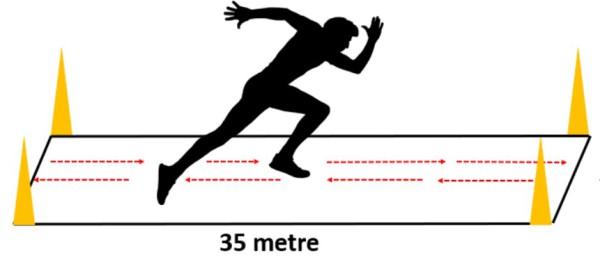
Online RAST test
RAST test is a field test that can be used to check and evaluate some variables of the athletes' anaerobic power. But what does the RAST test mean?
RAST is an abbreviation of the Running-based Anaerobic Sprint Test (RAST). In fact, by using this test, you can get a suitable evaluation of your athlete's speed and explosive power (Anaerobic Power).
How is this test implemented and how can the athlete be evaluated using it? Stay with us to learn how to examine this test.
The important variables that are calculated with the RAST test:
Maximum anaerobic power
Minimum anaerobic power
Average anaerobic power
Fatigue index
To run this test, you need the following:
- The field for running is 35 meters long, but there must be an empty space of at least 10 meters on each side on both sides of this field. Therefore, the total length of the land should be at least 55 meters.
- Two funnels to mark the distance of 35 meters
- Stopwatch
- Referee or evaluator
How to run the test:
To perform this test, we must first ask the athlete to warm up for at least 10 minutes. The athlete must be in perfect health on the day of the test and make sure his/her cardio and respiratory system are normal. Athletes' joints should be healthy and pain-free. Light clothing along with suitable shoes is important in performing this test.
First step: the athlete is placed at the starting line. With a Ready-Go order, the person runs as fast as possible for the entire distance of 35 meters. The person's record should be filed immediately.
Second step: the athlete rests for 10 seconds at the finish line and then prepares for the next start. With the current command (Ready-Go), the athlete must return the distance of 35 meters as fast as possible. We will have a 10-second break at the finish line along with setting the record.
Third step: The above steps should be performed in 3 rounds. That means a total of 6 records of 35 meters will be recorded for each athlete.
Important tips:
- For the proper execution of this test, at least 2 referees must be present, and if possible, a third referee must be present to record the records.
- Cooling down after the test is very important.
How will the variables in the RAST test be calculated?
1- In the first step, the speed in each step is obtained by dividing the distance on the record. So, at this stage, 6 speeds will be obtained for each of the 35-meter runs.
Velocity = Distance ÷ Time
For example, if a person runs a distance of 35 meters in 7 seconds, his/her speed is equal to 5 meters per second.
2- In the next step, the acceleration is calculated. Acceleration in speed will be equal to speed divided by the record.
Acceleration = Velocity ÷ Time
For a person with a speed of 5 meters per second and a record of 7 seconds, the acceleration is equal to 0.71 meters per square second.
3- At this stage, the force must be calculated, which can be calculated by multiplying the acceleration by the person's weight.
If in the previous example, the weight of the person is equal to 75 kg, then the force, in this case, is equal to 53.25
Force = Weight × Acceleration
4- In this step, which is the last step, the power is calculated. Power is equal to the product of force times speed
Power = Force × Velocity
That is, the power of our athlete at this stage is equal to 266.25
So, in summary, the power formula can be written as follows:
Power = Weight × Distance ² ÷ Time ³
We need to calculate the power in all 6 records and based on that we get each of the main variables as follows:
Maximum anaerobic power
The highest calculated number is the maximum anaerobic power based on the best record. That is the higher your speed, the lower your time record, and the higher your anaerobic power will be.
Minimum anaerobic power
The lowest calculated power is the minimum anaerobic power.
Average anaerobic power
To calculate this variable, the exponents in 6 records must be added together and then divided by 6.
Fatigue Index
To calculate the fatigue index, subtract the minimum power from the maximum power and divide the result by the total time of the records. The result is the fatigue index.
Important details
The anaerobic capacity of people is influenced by their physiological characteristics. People with fast-twitch fibers muscle and high levels of creatine phosphate and a strong phosphagen system have higher speed and, as a result, higher anaerobic power. Of course, it is recommended to compare people's anaerobic power by dividing it by their weight, and in this case, the relative anaerobic power will be investigated.
The higher the individual's anaerobic power, the higher the readiness and talent in speed and explosive activities. This variable is very important for fast and explosive athletes, and of course, training and consumption of some supplements will strengthen this index well.
The closer the fatigue index is to zero, the better it is, and it indicates that the athlete did not lose much due to fatigue in his records. One of the main variables in endurance in speed or endurance in power is the fatigue index. In people with an anaerobic capacity equal to this index, it can cause justice in judgment.
We have implemented a special online calculator for this test in this link to make your work easier for educators and researchers. You can easily see the result in this free online software by entering the records for any distance, and there is no need for a manual calculation.
Online RAST test
Thank You
Dr. Alireza Amani